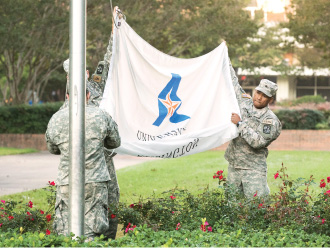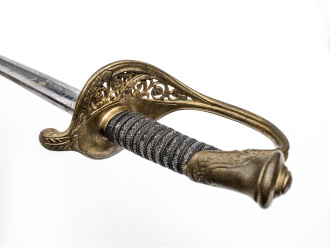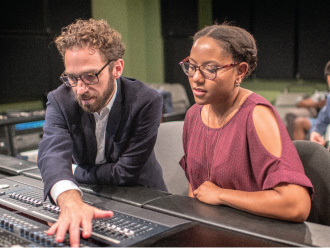As the storm ravaged South Texas, more than 40 student members of the Texas National Guard and the federal military reserves deployed to the area. During their activation, the students worked with their individual units on a variety of rescue and recovery efforts. Some searched through buildings to look for survivors, others cleared out rubble and opened roadways, and still others assisted the injured.
Additionally, four members of the UTA Police Department—Sgt. Tom Savage and officers John Morrison, Kris Ramirez, and Sharon Duty—volunteered to provide relief to their counterparts from the UT Health Science Center at Houston. For about a week, the UTA officers worked 12-hour shifts with officers from other UT campuses doing whatever was needed. Morrison says he spent the majority of his time loading, unloading, and transporting medical supplies or food. They hadn't known what to expect before they arrived—just that one of the other UT institutions needed help.
"We knew that if we were in a similar situation, they would provide the same for us," Morrison says.
IMMEDIATE SUPPORT
In Arlington, the University sent out emails to every member of the community who was known to be from one of the affected areas, checking on the safety of students and their families and letting them know that assistance was available—both academic and financial.
Hurricane Harvey had a particular impact on UTA's online students in the Houston area, most of whom were enrolled in College of Nursing and Health Innovation programs and had potentially lost internet access or supplies, or not been able to reach the facility where they were to perform their clinicals. For students taking three- to five-week classes, professors worked to adjust exam schedules to help them continue with their studies. When some students ultimately chose to skip a session, the University allowed them to roll their enrollment forward without penalty. The college also worked with students to extend tuition payment deadlines.
During Hurricane Harvey, Fang worked with researchers at Rice to help track and monitor the bayou’s water levels, allowing TMC officials to make timely decisions.
"The faculty as a whole was very supportive of those impacted and those serving," says Heather Snow, associate vice president for student affairs and dean of students. She says that in one large online chemistry class for nursing students, for example, about 50 percent of the students came from an affected area. To accommodate them, Seiichiro Tanizaki, assistant professor of practice in the Department of Chemistry and Biochemistry, created an entirely separate section of the course and shifted all of the deadlines. The new section gave students the first two weeks off and consolidated coursework so that all of the students would finish together at the end of the term.
UTA Libraries pitched in with relief efforts by hosting no-sew blanket workshops and joining forces with local libraries to collect used books and games to give to those temporarily living in shelters.
The previously scheduled Maverick Speakers Series lecture with actor and alumnus Lou Diamond Phillips, who hails from Corpus Christi, became a fundraiser for the University's Emergency Assistance Fund. Other events from early September also dedicated proceeds to the fund. UTA was ultimately able to award a total of $59,000 to 176 students who had unexpected financial needs due to the hurricane, which Snow says is about triple the amount awarded in any given year.
This photo by David J. Phillip reveals scenes that were all too commonplace during Harvey and its aftermath. The work of UTA researchers helped mitigate the storm’s impact.
RESEARCH IN ACTION
Hurricane Harvey caused severe flooding largely because the rain had nowhere to go. In a highly urbanized city like Houston, concrete prevents water from being absorbed. As a result, the epic amount of rainfall during the storm largely became runoff at many watersheds, says Nick Fang, assistant professor of civil engineering. For Texas Medical Center (TMC), which sits alongside the flood-prone Brays Bayou, that could have been devastating.
But in the 1990s, TMC—the largest medical complex in the world, with member institutions such as the UT MD Anderson Cancer Center—invested in a flood-alert system, which Dr. Fang helped develop when he was a doctoral student at Rice University. The current version, known as FAS4, feeds real-time rainfall data from the National Weather Service and rain gauges into a hydrologic model to predict streamflow. The process repeats itself every five to 10 minutes, and the system can predict flooding conditions two to three hours in advance, sending out warning messages to related emergency personnel.
During Hurricane Harvey, Fang worked with researchers at Rice to help track and monitor the bayou's water levels, allowing TMC officials to make timely decisions about closing their flood gates, installed after Tropical Storm Allison, which caused $2 billion in damage to the medical complex in 2001. TMC's proactive efforts during Harvey, aided by scientists such as Fang, allowed hospitals to stay open, serve patients, and minimize flooding.

Nick Fang’s research was vital for areas in and around Houston that were affected by flooding during Hurricane Harvey.
The flood-alert system has also been adopted by the Texas Department of Transportation and the cities of Sugar Land and Grand Prairie. FAS4 is one of the "very few reliable operational systems in the nation," Fang says. "We're hoping a similar system can be applied to more flood-prone areas to benefit those communities."
During the hurricane, Fang also worked closely with a group of experts brought together by the Texas Division of Emergency Management and the U.S. Army Corps of Engineers, participating in a conference call every morning for the duration of the disaster. Utilizing radar rainfall data from the National Weather Service and a hydrologic model, Fang and his team created runoff predictions, then fed that information into a hydraulic model to create a series of floodplain maps of Harris County. This provided decision-makers with a better understanding of the situation on the ground, allowing them to see, for example, which areas vehicles would be able to pass through in order to provide emergency assistance.
Hurricane Harvey was not Houston's first experience with flooding, and likely not its last. Parts of the city were also underwater in 2015 and 2016, and "Harvey gave us another concerning data set," Fang says. He has been serving as a reviewer on the National Oceanic and Atmospheric Administration Atlas 14 project, which uses historical data to predict how much rain any given area might see in 24 hours during a 100-year, extreme precipitation event. Those estimates—which are now in the process of being raised for Houston—are important, affecting the building of homes and infrastructure like dams and levees. "They're going to change the way that people develop design criteria," Fang says.
LONG-TERM SOLUTIONS
Hurricane Harvey eventually moved out of the Lone Star State, but it left behind an estimated $125 billion worth of damage, second only to Hurricane Katrina in the period of record, that would take time to clean up.
In the aftermath, several media outlets reported that experts were concerned that lingering debris could be hazardous to residents' health, bringing mold and mosquitos, among other things, to already hard-hit areas.
In October 2017, civil engineering doctoral student Surya Sarat Chandra Congress and Cody Lundberg, a research engineer at the UTA Research Institute, traveled to Beaumont. There, they worked closely with city officials and personnel from the emergency management office to collect data in order to develop a framework that better estimated the debris that remained on city streets, which could help municipalities improve future cleanup efforts.

Anand Puppala (second from right) and students work with a TxDOT drone. The team used drones to survey debris after Hurricane Harvey.
With the support of a yearlong Rapid Response Research grant from the National Science Foundation, Lundberg, an FAA-certified pilot, conducted 15-minute unmanned aerial vehicle (UAV) flights to take overlapping photographs of 14 different debris piles at eight sites while Congress served as a visual observer. Anand Puppala, associate dean for research in the College of Engineering and principal investigator on the Beaumont project, provided guidance; Junzhou Huang, an associate professor in the Department of Computer Science and Engineering, was co-principal investigator.
“It’s important for a city to get a handle on the debris volume so it can know how much money it has to invest in this kind of cleanup operation.”
At the same time, collaborators from Louisiana State University used a smartphone camera to capture images of the same stockpiles. Once back at UTA, Congress used photogrammetry to create highly accurate 3D models estimating the volume of each pile of trash.
"It's important for a city to get a handle on the debris volume so it can know how much money it has to invest in cleanup," Dr. Puppala says. "Otherwise, if more resources are needed, removal work could be delayed."
Puppala's team has built its expertise in this research area in part through its work with TxDOT. In an 18-month infrastructure-monitoring project that ended in April, they used UAV photographs to estimate the volume of homogeneous stockpiles of materials such as sand. However, Puppala notes that Beaumont's debris piles—composed of a mix of ruined personal items and furniture, building materials like sheetrock, and fallen tree limbs—were highly heterogeneous, complicating the task of estimating them. The researchers will use landfill records provided by the city of Beaumont to validate their methodology and see how close their estimates were to the amount of debris that was actually picked up.
Accuracy is key, and the team has perfected its algorithm to a high degree. "Any time someone makes an error of a few cubic yards, multiply the number of stockpiles in front of every home by the number of subdivisions, and you're looking at a vast underestimation of the total," Puppala says.
Photograph by Edouard Bense (aerial)
The researchers say the step-by-step methodology they're developing for both drone-based and smartphone-based debris estimation could aid emergency officials after future disasters.
"Everyone has a drone nowadays and everyone can collect photos," Congress says, "but they need to know how to use the data effectively, which we're providing."
Puppala notes that UTA is a leader in UAV research, with multiple departments working on different applications. During Hurricane Harvey, Fang and his team, in partnership with collaborators from Rice and Texas A&M University at Galveston, used UAVs to gather data on the state of coastal vegetation from Corpus Christi to Galveston, both before and after Harvey hit. That will enable them to see how the hurricane impacted coastal erosion. Meanwhile, Yan Wan, an associate professor in the Department of Electrical Engineering, is using a three-year, $998,803 National Science Foundation grant to build a multi-drone networked aerial computer system that could provide real-time information during emergency operations.
While the 2018 hurricane season is well underway, experts are predicting a quieter period than the one that created Harvey. However, that doesn't indicate impact—it's unknown, of course, where storms will make landfall before they form. Whatever happens, UTA is ready to lend compassionate support and expert knowledge whenever help is needed.


